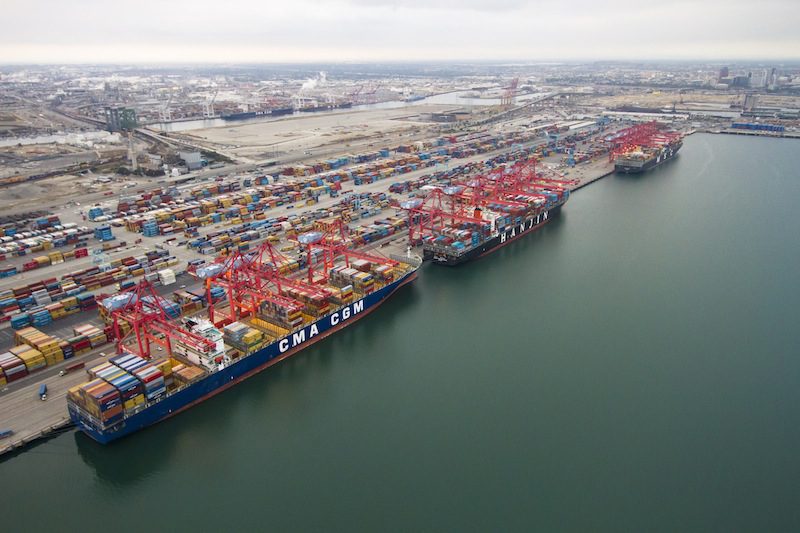File photo: Port of Long Beach
By James Nash and Matthew Winkler
(Bloomberg) — Electronics, auto parts and clothes from Asia are streaming through the second-busiest U.S. port at record levels, signaling retailers’ confidence in the economy and consumers’ eagerness to buy.
The Port of Long Beach– which is poised to overtake neighboring Los Angeles next year to become the No. 1 shipping gateway in the country — had a record month in July, with cargo volume up 18 percent from July 2014. Figures being released later this month will show unprecedented traffic again in August, and early signs in September are “very very encouraging,” Jon Slangerup, the Long Beach port’s chief executive officer, said in an interview at Bloomberg’s offices in New York last week.
Overall, the two ports are handling 4 percent more cargo this year than last, Slangerup said. With consumers showing no letup, he predicted a record year for Long Beach in 2015, taking out pre-recession highs set in 2007. West Coast ports are poised to regain share lost earlier in the year, when backlogs led clients to divert cargo to East Coast destinations like Savannah, Georgia, he said.
“When you look at the macros, you look at unemployment, consumer confidence, savings, available discretionary spending, all of those numbers suggest that we have more to spend,” Slangerup said. “The economy here is super strong relative to the rest of the world, and the strongest I’ve seen it in a very long time.”
Traffic at the Port of Los Angeles has been less impressive; after the second-best month ever in March, volume was down in three of the next four months. Still, the overall trend is encouraging, and orders for next year suggest volumes will pick up late this year, said Gene Seroka, executive director of the Port of Los Angeles.
“It’s not just a big one-time spike during the peak season,” Seroka said.
Both ports lost business during a dispute between the labor union for 20,000 dockworkers and their employers, which all but paralyzed the 29 commercial seaports on the West Coast for four months. Slangerup said in February that labor issues accounted for 80 percent of a bottleneck that kept as many as 36 vessels idling at sea for days at a time.
In the interview last week, however, he said he realized that labor had “very little to do” with the disruptions, that the difficulties had more to do with organizational glitches and inefficient cargo-handling practices.
Since March, truckers, shippers and terminal operators at both Southern California ports have been meeting to better coordinate operations and speed cargo through the port complex. Union representatives have joined the conversations.
“They recognize that by being at the table in our discussions with everybody, just how critical a link they are and how they have the ability to make and break it,” Slangerup said. “They get it. They lost a lot of hours.”
The Federal Maritime Commission granted Los Angeles and Long Beach permission on Feb. 26 to work together by taking measures such as creating a pool of truck chassis to haul cargo containers. The logjam largely disappeared by May.
Retailers such as Wal-Mart Stores Inc. and Home Depot Inc. have expressed confidence in the Port of Long Beach, while maintaining a four-corner strategy that includes cargo through other gateways, Slangerup said. Port officials have met with more than 300 customers, some of whom spent millions of dollars daily on alternate routes.
“Nobody is going to spend 30 percent more just because they don’t like the system,” Slangerup said.
The adjacent ports on San Pedro Bay handle almost a third of all cargo entering and leaving the U.S. They moved $470 billion in goods last year, more than double that of the Port of New York and New Jersey.
The West Coast ports rely heavily on trade with China, where economic growth has been slowing and the government unexpectedly devalued the yuan in August, rattling global markets. China accounted for 49 percent of the value of cargo moving through Los Angeles last year, and 48 percent of the tonnage in Long Beach, according to data from both ports.
Imports from Asia to North America, aided by record car sales, increased more than 10 percent in June from a year earlier, according to Bloomberg data.
“These are some of the largest numbers in our history, far exceeding the pre-recession numbers,” Slangerup said.
Overall, the climate for global shipping is improving, according to an analysis by Bloomberg Intelligence. About 78 percent of the Bloomberg Intelligence global marine shipping peer group is expected to generate positive earnings per share this year and 83 percent next year, up from 65 percent in 2014, according to research by analysts Lee Klaskow and Talon Custer.
The dispute cost Los Angeles about 400,000 units of cargo, equivalent to more than two weeks of volume, Seroka said. “A lot of the numbers post-agreement look pretty good, but we lost a heck of a lot of business.”
To keep their lead and regain earlier losses, the Southern California ports are spending a combined $5.8 billion to expand capacity, replacing a bridge and dredging harbors to accommodate the biggest vessels, and automating unloading, warehousing and other activity.
The projects could maintain the West Coast dominance in handling ever-larger container ships from Asia, as rivals in New York-New Jersey; Norfolk, Virginia, and Savannah also increase capacity and add automated features to speed cargo movement.
Early next year, some large ships that have docked in Southern California will have more options when new locks and a deeper channel in the Panama Canal allow them to reach the East Coast and Gulf Coast. Slangerup downplayed the threat, saying that drought caused by climate change may make it harder to fill the locks.
“They may not be able to operate at certain times of the year,” Slangerup said.
To accommodate the latest generation of larger ships, East Coast ports have to dredge their harbors after major storms year-round, Slangerup said.
“They can dredge all they want, but they’re fighting Mother Nature because every time a storm comes in, they have to dredge again,” he said.
Los Angeles and Long Beach have other built-in advantages, including an inland rail infrastructure, that limit any migration of cargo, said Chas Deller, chief executive of 10XOCEANSOLUTIONS Inc., a maritime consulting company in the San Francisco Bay Area.
“Los Angeles and Long Beach will always be the No. 1 choice,” Deller said.
–With assistance from Shin Pei in New York.
©2015 Bloomberg News

 Join The Club
Join The Club











